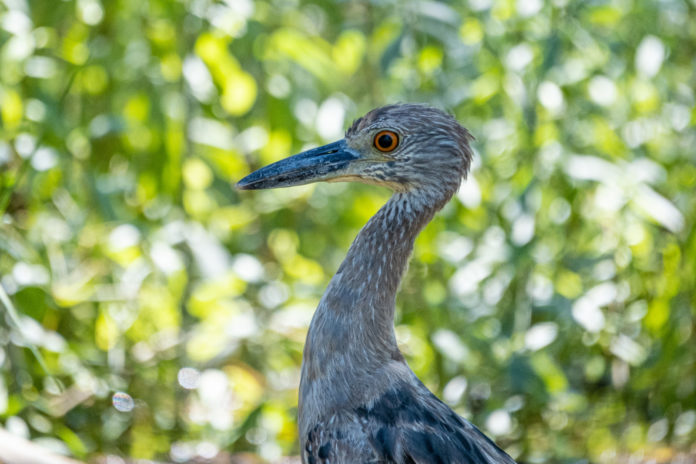The storm had just ended and it was as if someone had flipped a switch. The sky was blue, the wind was gone, the humidity felt a little vengeful.
It happened so quickly it apparently caught out the professional weatherpersons, so now they were standing in a puddle, in their matching blue professional weatherperson costumes, in front of the only 20-yard section of the Higgs Beach sea wall where there were any waves at all.
It had to be pretty sweaty inside those zipped-up raincoats and bib pants, but it no doubt made things look worse than they were on a TV screen and stretched out the drama for their ratings.
I took a walk out on the pier and saw a lot of people doing the normal things – riding bikes, fishing, walking dogs, staring wistfully at the sea – and when I got back to my car the weatherpersons were gone, replaced by a group of happy 6-year-olds splashing in the same puddle.
The only bird I’d seen was a magnificent frigatebird hanging motionless over West Martello like some kind of detached light fixture. It’s possible I’d seen a gull or a pigeon but just edited it out of my consciousness.
Across the street, at the foot of the FAA tower, the grass was flooded and a mishmash of birds was trying to make up for whatever calories they’d missed during the storm – two dozen starling, a dozen cattle egrets, half-a-dozen white ibis, a snowy egret, a great egret, a grab bag of doves. Gray kingbirds made sorties off the barbed wire. Northern mockingbirds stood around and tried to yell at everyone.
Seeking a little shade, I drove down to the swale just outside of Indigenous Park on Stevens Avenue. Most of the year it’s just a weedy little indent in the ground, but when the rains come, it tends to fill up and can occasionally attract a good bird or two. I thought maybe there was a chance for a teal or a spoonbill or something.
I started to open the door but then stopped. There was a yellow-crowned night-heron standing stock still less than 10 feet from the car.
Yellow-crowned night-herons are some of the more common birds in the backcountry, but you do see them around Key West occasionally, generally in places where the ground is soft and there’s a good bit of shade. Yellow-crowned night-herons are about a foot tall and have short necks, as herons go, and thicker, more solid-looking bills. They can be very striking in a muted color palette kind of way, a trim gray with a black head, a bold white slash under each eye, the nominate yellow crown, and, at the right time of year, long feathers that hang off the back of their head like tally ribbons on an old timey sailor’s cap.
This one, though, was a juvenile, brown with flecks of gray and white in a pattern that made it look dull and tweedy.
The bird was watching me, but not moving. It was hard to say if it wasn’t moving because it saw me or because it was just doing what it was going to do anyhow. Yellow-crowned night-herons are some of the lowest-energy hunters out there. People who have studied them showed that, while they hunt, they can spend more than three-quarters of their time in “stand and wait” mode, a fifth of their time “peering,” and the rest in “walk slow” mode. It works for them. They don’t dig the crabs or other crustaceans out of the mud. They find the appropriate habitat – usually within three meters of water – become part of the scenery and wait for their prey to move into their proximity.
They are so good at this that when the closely related Bermuda night-heron went extinct – most likely due to heavy human inhabitation – Bermuda became so overrun with crabs that it was difficult to walk anywhere without crunching on crustaceans. They had to import yellow-crowned night-herons to restore the ecological balance.
Adult yellow-crowns have red eyes, but this juvenile’s were more of an amber-orange, which jibed with the earthy tones of its plumage. And I was curious what that eye led it to comprehend. Cars can work as blinds. The birds no doubt see you, but they often don’t consider you a threat until you open the door.
Sight is a bird’s strongest sense. Their eyes are the largest, proportional to body size, of any land vertebrate. And whereas human eyes tend to have about 200,000 receptors per millimeter, birds can have between 400,000 and 1 million per millimeter. And their brains are built to process that information quickly. Also, where humans have eyes on the front of their head and typically have about a 120-degree visual field, birds’ eyes are generally on the sides of their heads, and can have a much wider field of view. (The American woodcock has a full 360-degree field of vision.)
My optical standoff with the yellow-crown lasted a few minutes. Then the bird seemed to make a decision. It silently turned and without fanfare shifted from stand-and-wait mode to walk-slow mode. I thought it brave to turn its back on me like that, especially as it was declining to hurry. But then I lifted my camera to take a few shots, and through the long lens could see the night-heron wasn’t fully 90 degrees facing away from me, but about 85 degrees. And I could see the broad convex arc of its eye curving out from the side of its head. Meaning it could still see me.
I waited until he stepped behind a rock and the visual link between us was broken, then I put the car into gear and slowly drove on.

























